- Details
- Written by Gordon Prentice
Metrolinx will be giving a presentation to councillors on Monday (10 April) on the Regional Express Rail (RER) expansion programme and how it will impact on the Town. (See the Committee of the Whole agenda here.) 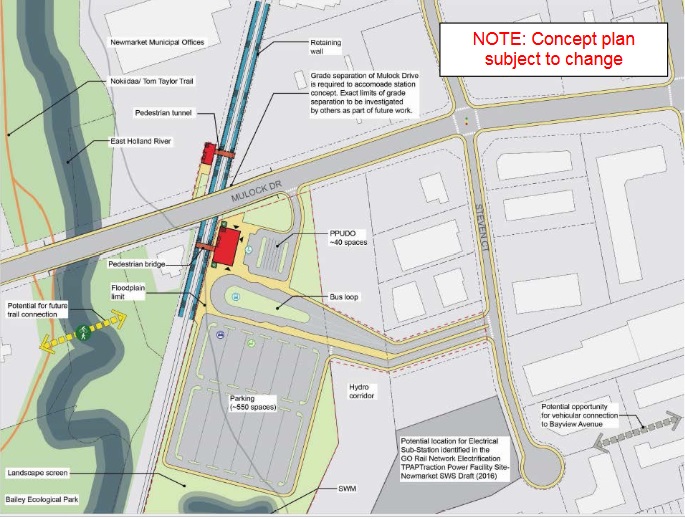
There are two key projects in the pipeline: the Newmarket GO Rail Station Mobility Hub Study at the Tannery and the Concept Plan (right) for the proposed new GO Rail Station at Mulock Drive.
Metrolinx has commissioned consultants IBI to look at the
"potential for grade separation of the rail line at Davis Drive" .
The reports tells us there will be a preliminary evaluation to understand the feasibility of a grade separation which was not identified as a priority.
Oh dear! It doesn't sound terribly urgent to me but perhaps I'm just reading it the wrong way. (The grade separation study is being done at the request of the Town.)
Metrolinx Manager of RER Project Planning, Nadine Navarro, told me last month there will be public consultation in the Spring with the Study completed by the end of summer.
Is this remotely feasible if grade separation is to be part and parcel of the completed study?
Prepare to be told grade separation is something for later, not for now.
I suspect grade separation - inevitably involving huge sums of public money - is a can that will be kicked down the road for a good while to come.
The report tells us there will be a non statutory public Open House in early May.
Planning for the proposed Mulock GO Rail Station is still very much in its early stages.
I hope the Mayor has one or two penetrating questions to ask about these transformational projects if only to show he is listening and following things.
Metrolinx gave a presentation to members of York Regional Council last month which included two hot potato issues - level crossings and the new GO rail stations. Van Trappist, head down, was glued to his cell phone, contributing nothing to the debate.
This email address is being protected from spambots. You need JavaScript enabled to view it.
- Details
- Written by Gordon Prentice
As we know, one third of Newmarket councillors' remuneration comes tax free. The policy was reaffirmed on 20 March 2017. 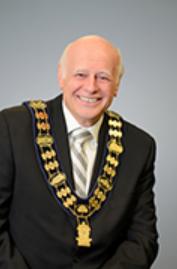
This allows Van Trappist's remuneration to appear as $117,162 on the Sunshine List rather than $148,560 if he paid tax on his entire income just like the rest of us have to do.
(Of course, $148,560 is not his "entire income" but let's not muddy the waters.)
Some municipalities have gotten rid of tax free status and others like Newmarket cling on to it, making meaningful comparisons between municipalities impossible. The bald, unqualified figures shown in the Sunshine List are worse than useless.
Yesterday, after Kathleen Wynne told us the Sunshine List is here to stay, I wrote to my MPP, Chris Ballard, asking if it could be tweaked in some way, perhaps by putting an asterisk after Van Trappist's name (and others in the same category) indicating a portion of their remuneration is tax free.
 According to the relevant Newmarket Council by-law (R7-2002) the one third tax free for elected officials is
According to the relevant Newmarket Council by-law (R7-2002) the one third tax free for elected officials is
"deemed to be for expenses incident(al) to the discharge of their duties".
I am left wondering if Van Trappist can point to a single expense borne by him that is not already picked up by the Town.
Maybe there is one.
He doesn't claim a cell phone subsidy.
But why not?
It seems quite out of character.
This email address is being protected from spambots. You need JavaScript enabled to view it.
Update on 4 April 2017: This is from the Aurora newspaper on 11 March 2011.
While Newmarket Mayor Tony Van Bynen carries a BlackBerry and embraces technology as the new way to engage residents in town business, he doesn’t agree council meetings are the place to use it. “I have noticed an increase in use during meetings and it has become problematic,” he said.
Short-changing the taxpayer
“I think it’s not only disrespectful to your colleagues, because it says you’re not listening, but you are short-changing the taxpayer, too.”
It is difficult for anyone to do two things at once, he noted. Only half of the information, half of the discussion and half of the debate will be absorbed if you’re busy typing on an electronic device.
How is someone to make an educated decision on an issue, especially something as complicated as the budget, without hearing every point made? Mr. Van Bynen asked.
Newmarket has yet to discuss the need for a cellphone policy, but Mr. Van Bynen doesn’t think it will be long before he brings forward the issue.
- Details
- Written by Gordon Prentice
If a Monster Home goes up in your neighbourhood and you have concerns, what can you do about it?
The short answer is you are on your own. Don't look to the Town for help. 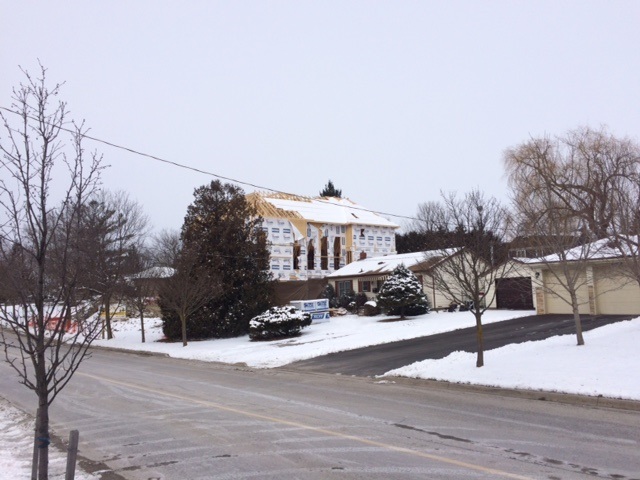
A few days ago an email came winging in from a certain Mr X, eager to let me have his views on my earlier blog about the huge structure taking shape at 1011 Elgin Street. He lives in the same street.
"You use the words "seems like" and "appears" in your article. But you don't say "it is". So you don't know, do you?"
He goes on:
"Were there any objections by neighbours to the size of the house?"
I'll take these points in turn.
After I discovered this monster home going up in a low rise residential neighbourhood, I contacted the Town. I told the Director of Planning, Rick Nethery, I was concerned that:
"before long this low rise residential neighbourhood is going to be studded with huge, out of place, monster homes, transforming the character of the area. The zoning by-laws as they stand clearly offer residents no protection from monster homes."
Mr Nethery told me:
"Essentially the proposal (for the new building at 1011 Elgin Street) only required a routine building permit issuance as it complies with the relevant zoning requirements in respect of height, setbacks and lot coverage." 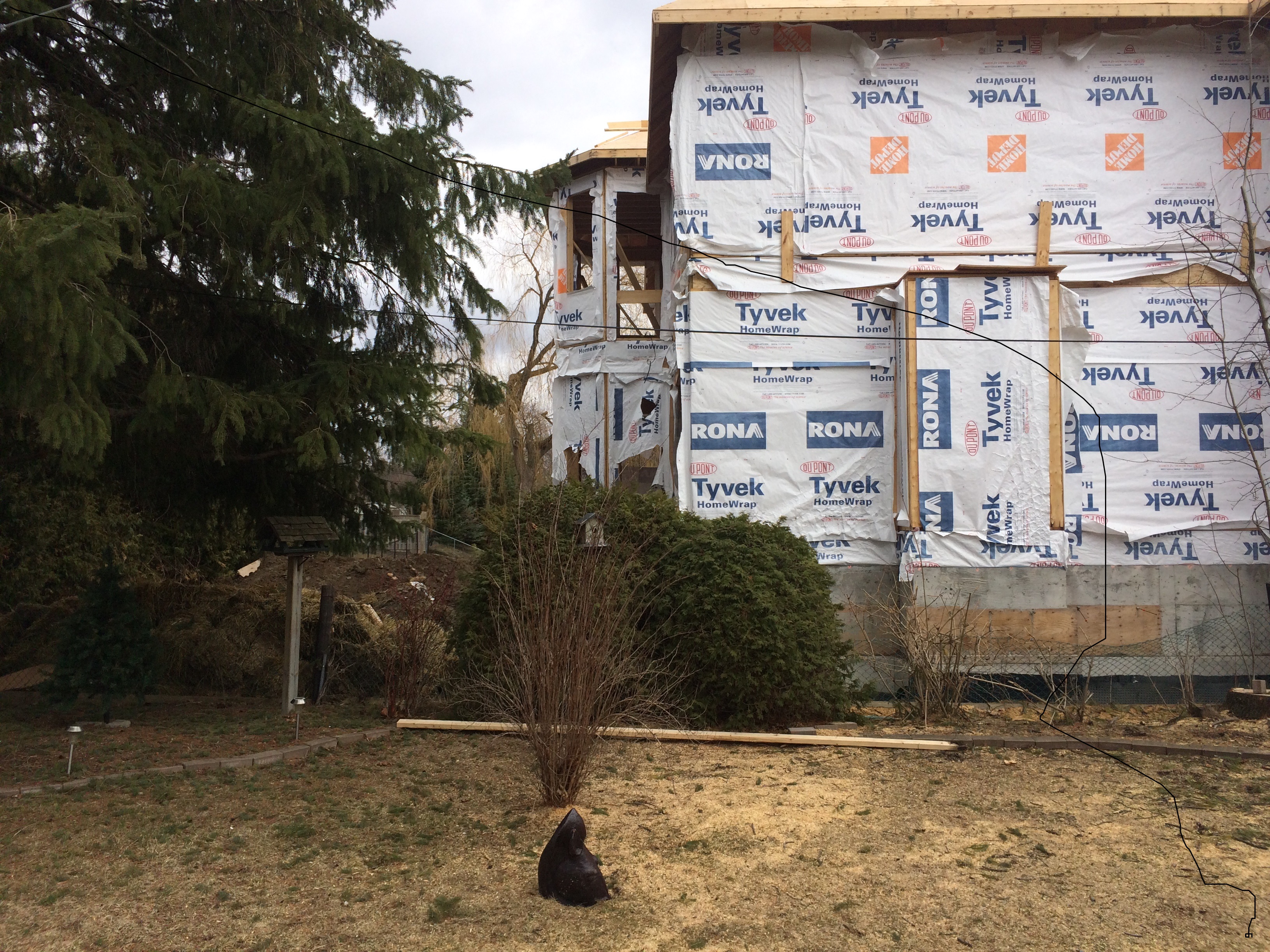
It seemed to me - a complete layperson who knows nothing about surveying - the monster home just didn't look right. It seemed way too big for the lot. (It reminded me of the monstrous Clock Tower development which to the untrained eye seemed way too big, yet the professionals appeared to suggest that, with a tweak, it could be made to fit in.)
Mr Nethery was happy to show me the site plan - and I was grateful - but what if the building under construction was bigger than what was shown in the plan or was situated too close to the property line?
He told me measuring a structure "in the field" was not something the Town’s Building Division could do. It would have to be done by an Ontario Land Surveyor.
And who, I asked, would commission this?
Not the Town. It would be up to me! Or anyone else with concerns. 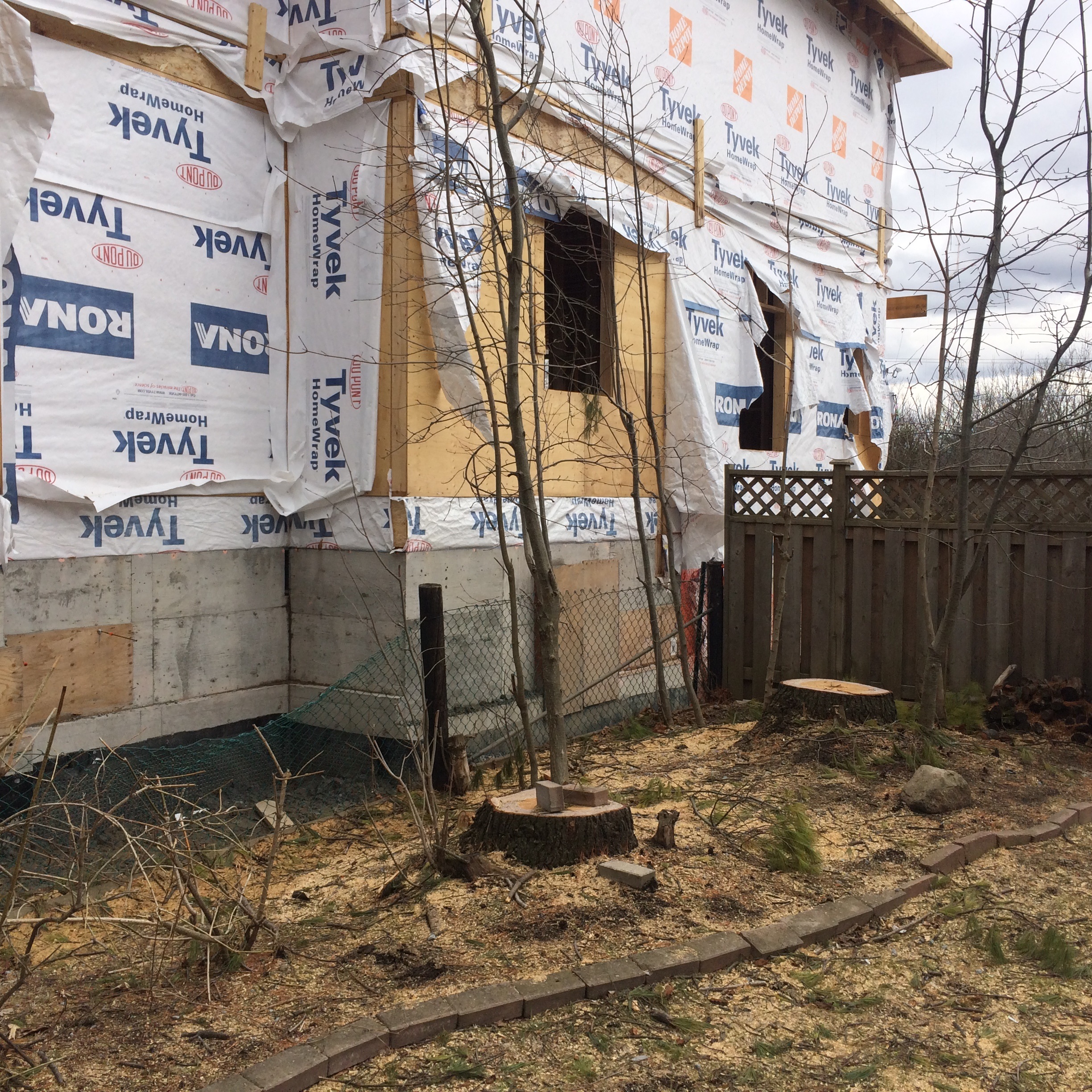
Which brings me to Mr X's second point - did anyone complain?
If the Town does not police its own by-laws does it fall to members of the public to step in to the vacuum if they have concerns?
Mr Nethery tells me:
"It is not a requirement of either the Building or Planning Division to "police" the location of a dwelling after construction. When applying for a building permit, an applicant submits a site plan, typically prepared by an engineer, architect, designer or surveyor to confirm compliance with the zoning requirements regarding setbacks, coverage etc. The preparer of the site plan is therefore responsible for ensuring the accuracy of the information submitted."
He goes on
"I don't know if I'm in any better position than you in determining the setbacks in the absence of a survey however I can't conclude that the property is not in compliance."
Led up the garden path 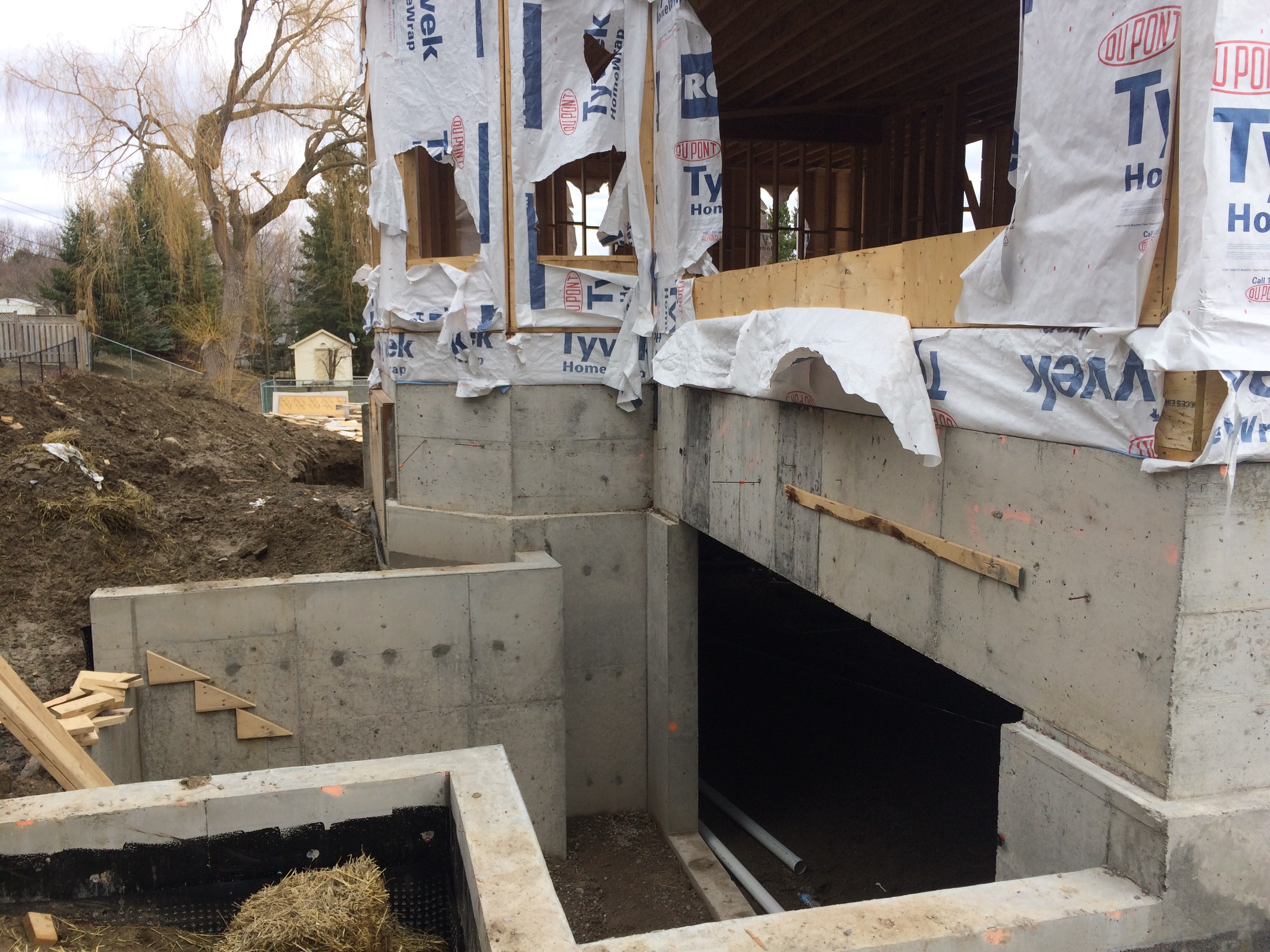
Yet he concluded the property was in compliance when he visited 1011 Elgin Street after receiving a request from a councillor to do so.
Following his site visit several weeks ago, he now tells me on Friday (31 March 2017)
"I satisfied myself that the permit that was applied for was in compliance with the relevant requirements and didn't feel further action was necessary."
Why on earth didn't he say that earlier rather than spin this yarn about his views being no more authoritative than mine?
Mr Nethery now offers an olive branch and
"Under the circumstances of your on-going concern, we will contact the applicant to determine if there is or will be a survey they could share with us to determine compliance."
But what if the owner says no?
Does the Town employ a surveyor or have one on a retainer for this kind of eventuality? And if not, why not?
The issue of "who complained?" is beside the point.
A better question is this:
Who represents the wider public interest - and ensures its own by-laws are being complied with - if it is not the Town of Newmarket?
This email address is being protected from spambots. You need JavaScript enabled to view it.
The site plan for the property under construction at 1011 Elgin Street indicates:
Front yard setback of 9.88 metres. (minimum 7.5 metres required)
Side yard setback of 1.83 metres. (minimum 1.8 metres required)
Rear yard setback of 10.71 metres. (minimum 7.5 metres required)
Lot coverage of 31.33% (maximum 35%)
- Details
- Written by Gordon Prentice
It is up to you folks! Take your pick!
There are many definitions of remuneration. The Town’s Treasurer, Mike Mayes, sets them out here in all their bewildering complexity.
So if anyone has the temerity to ask Van Trappist how much he makes, the Mayor can pick the pay package that best suits the occasion. 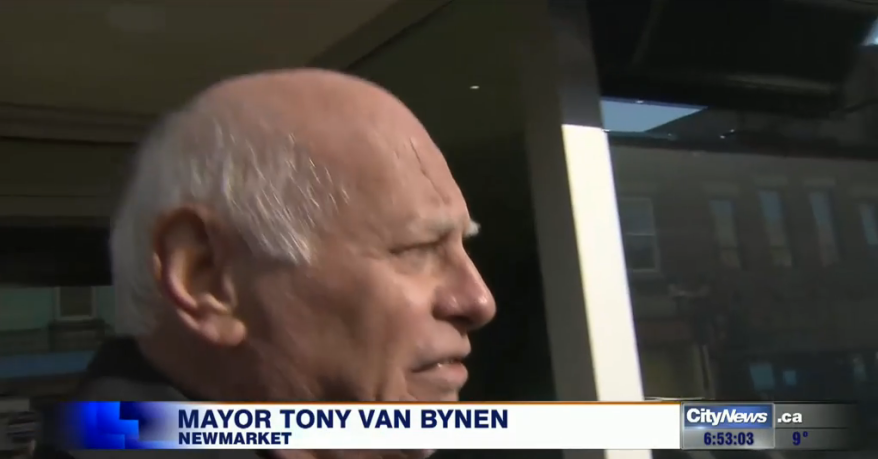
In most cases this would be the lowest. But in the unlikely event of the old banker wanting a bank loan he could be tempted to select his highest remuneration.
Mr Mayes, the man with the abacus, tells us
“Remuneration for (the) purposes of the annual Statement of Remuneration and Expenses is based on payments and includes the non-taxable portion of council wages, but does not include payments not ultimately made by the Town, such as those reimbursed by the Region.
“For Public Salary Disclosure purposes, remuneration is derived from the elected official’s T4 form and therefore includes only the taxable portion of Town wages and Regional stipend. It can be confusing.”
Hmmmm. Some of the calculations seem adrift by a few dollars here and a few dollars there. I don't pretend to understand it all. But if I’ve got the gist of it right:
(a) $117,162 is Van Trappist’s income as shown on the Sunshine List. It derives from the two-thirds of his Town remuneration on which he pays tax ($62,814.94) plus the so-called "stipend" of $54,337.92 from York Region. This gives a total of $117,152.86. I am a few dollars adrift from the Sunshine List figure which I cannot immediately explain.
If the Mayor paid tax on his whole income from the Town and not just two-thirds, his Sunshine List remuneration would be that much higher.
Regional Councillor John Taylor does not feature in the Sunshine List even though his combined income - like the Mayor's - is greater than the $100,000 threshold.
(b) $148,560 is the Mayor’s income as reported in the Town's annual statement of Remuneration and Expenses. This is his $94,222.41 from the Town of Newmarket and his $54,337.92 from the Region of York. He is on the Region because he is Mayor.
(c) $160,564 is the Mayor’s income as above together with the $12,004 he gets from Newmarket-Tay Hydro. He is only on the Board because he is Mayor.
Is that clear enough?
Appendix A in the Statement of Remuneration and Benefits tells us:
|
|
Remuneration |
Benefits per T4 (lease car) |
Other Benefit Costs (OMERS, CPP etc) |
Remuneration and Benefits
|
Other Expenses |
Total |
|
Tony Van Bynen |
$94,222.41 |
$7,651.62 |
$15,320.69 |
$117,194.72 |
$8,560.93 |
$125,755.65 |
Appendix B on Income Reporting says this: (The employment income figure is the one shown on the Sunshine List)
|
|
Employment Income |
Municipal Officers’ Expenses Allowance. Tax free 1/3rd |
2016 Remuneration per T4 |
|
Tony Van Bynen |
$117,162.21 |
$31,398.12 |
$148,560.33 |
Source of remuneration (shown above). Benefits are excluded from these figures.
|
|
York Region |
Town |
Total Remuneration |
|
Tony Van Bynen |
$54,337.92 |
$94,222.41 |
$148,560.33 |
2016 Payments made to Members of the Regional Municipality of York Council
|
|
Remuneration |
Benefits per T4 |
Other Benefit Costs |
Remuneration and Benefits |
Other Expenses |
Total |
|
Tony Van Bynen |
$54,337.92 |
|
$8,992.79 |
$63,330.71 |
$4,863.62 |
$68,194.33 |
|
John Taylor |
$54,337.92 |
|
$8,908.33 |
$63,246.25 |
$1,193.38 |
$64,439.63 |
Payments made to members of Newmarket-Tay Hydro. Van Bynen is appointed by the Council to the Board and is there by virtue of his position as Mayor.
|
|
Remuneration |
Benefits per T4 |
Other Benefit costs |
Remuneration and Benefits |
Other Expenses |
Total |
|
Tony Van Bynen |
$12,004 |
|
|
$12,004 |
|
$12,004 |
Sunshine List for members of York Regional Council
And here are the Sunshine List figures for members of York Regional Council. As with Van Trappist above, these figures do not give the whole picture. You've got to take them with a shovel full of salt.
The Sunshine List has serious design flaws and is worse than useless. The figures cannot be relied on.
Aurora's Geoffrey Dawe appears on the Sunshine List for the first time even though his combined income from Aurora and York Region would have put him over the $100,000 threshold in the past.
I also note that Vaughan’s Michael Di Biase whose pay from the City of Vaughan in 2015 was docked for 90 days for improperly interfering in the tendering process, has bounced back with a vengeance, recovering the cash that he lost for his questionable behaviour.
|
|
Municipality |
2016 |
2015 |
2014 |
|
Mayor Geoffrey Dawe |
Aurora |
$100,829 |
nothing reported |
nothing reported |
|
Mayor Virginia Hackson |
East Gwillimbury |
$124,094 |
$126,035 |
$119,772 |
|
Mayor and Regional Councillor Margaret Quirk |
Georgina |
nothing reported |
$106,806 |
nothing reported |
|
Mayor Steve Pellegrini |
King |
nothing reported |
nothing reported |
nothing reported |
|
Mayor Frank Scarpitti |
Markham |
$187,881 |
$187,129 |
$191,996 |
|
Deputy Mayor and Regional Councillor Jack Heath |
Markham |
$137,330 |
$136,778 |
$140,163 |
|
Regional Councillor Jim Jones |
Markham |
nothing reported |
nothing reported |
nothing reported |
|
Regional Councillor Joe Li |
Markham |
nothing reported |
nothing reported |
nothing reported |
|
Regional Councillor Nirmala Armstrong |
Markham |
$129,785 |
$129,262 |
nothing reported |
|
Mayor Tony Van Bynen |
Newmarket |
$117,162 |
$120,494 |
$113,921 |
|
Regional Councillor John Taylor |
Newmarket |
nothing reported |
nothing reported |
nothing reported |
|
Mayor David Barrow |
Richmond Hill |
$180,958 |
$174,281 |
$173,379 |
|
Regional Councillor Vito Spatafora |
Richmond Hill |
$130,310 |
$126,193 |
$125,291 |
|
Regional Councillor Brenda Hogg |
Richmond Hill |
$130,310 |
$126,193 |
$125,291 |
|
Mayor Maurizio Bevilacqua |
Vaughan |
$179,040 |
$176,919 |
$173,459 |
|
Deputy Mayor and Regional Councillor Michael Di Biase |
Vaughan |
$139,902 |
$117,603 |
$128,778 |
|
Regional Councillor Mario Ferri |
Vaughan |
$132,122 |
$130,706 |
nothing reported |
|
Regional Councillor Gino Rosati |
Vaughan |
$132,122 |
$130,706 |
$135,041 |
|
Mayor Justin Altman |
Whitchurch Stouffville |
nothing reported |
nothing reported |
nothing reported |
|
|
|
|
|
|
Health Warning: Check out the Sunshine Lists:
2016 here
2015 here
2014 here
This email address is being protected from spambots. You need JavaScript enabled to view it.
- Details
- Written by Gordon Prentice
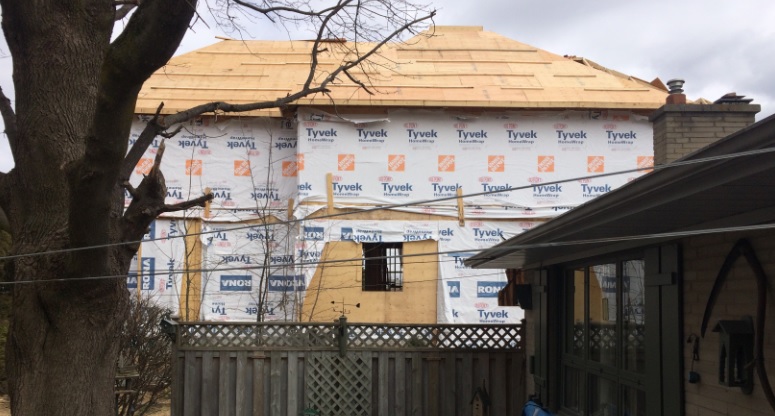
The Monster Home that is currently under construction at 1011 Elgin Street did not require any approvals or permissions from the Town because it, apparently, meets the zoning requirements.
If this is indeed the case then the Town's zoning standards need a complete overhaul.
The standards offer no protection for people living in long-established low-rise neighbourhoods where the lots are relatively generous.
The Director of Planning, Rick Nethery, tells me:
"Essentially the proposal (for the new building at 1011 Elgin Street) only required a routine building permit issuance as it complies with the relevant zoning requirements in respect of setbacks, height and lot coverage."
The relevant zoning standards stipulate that the maximum lot coverage should be no more than 35%. I appreciate the eye can deceive but the footprint of the monster house seems way more than that. 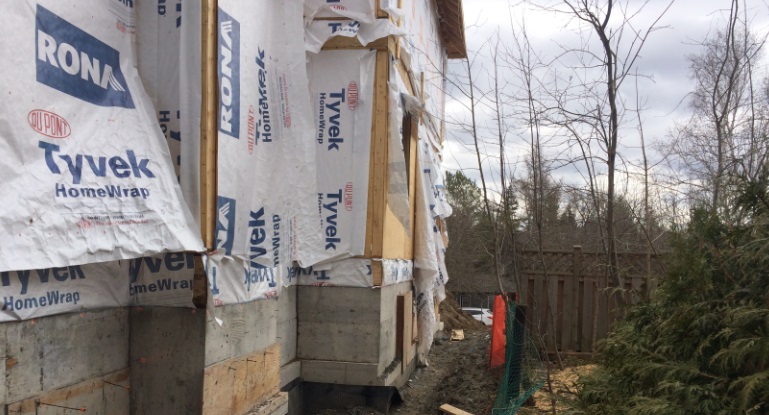
The monster home also appears much closer to the lot or property line than the zoning standards stipulate. At its closest point it is supposed to be at least 1.8 metres (or 5' 9") from the lot line. To me it seems more like 1.2 metres or 4 feet away. It is unquestionably less than 1.8 metres. (The posts and green netting show the property line.)
The Council should embark on a review of zoning standards to see if they are still fit for purpose.
If nothing is done, stable low rise residential neighbourhoods across Newmarket are going to be studded with huge, out of place, monster homes, transforming the character of the area.
For too many Newmarket residents, the zoning by-laws as they stand give absolutely no protection whatsoever from the looming invasion of monster homes.
1011 Elgin Street is all the proof you need.
This email address is being protected from spambots. You need JavaScript enabled to view it.
Page 176 of 286